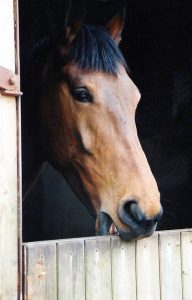Oral stereotypic behaviors are mainly observed among ungulates (e.g. cows, horses, pigs etc.) held in captivity. Oral stereotypies involve the usage of the mouth in performing a functionless repetitive behavior that is not linked to the digestion of food (Bergeron et al., 2006).
- When are they expressed? Oral stereotypies are usually expressed at high frequency around the feeding time of the animal, and can last up to 8h (Bergeron et al., 2006).
- How prevalent of oral stereotypies are? Oral stereotypies have a high prevalence rate among farm animals, and can go up to 50% of the animals within one farm (Rebdo, 1992).
Examples of common oral stereotypic behaviors:

Crib biting or wind sucking:
This is a stereotypic behavior observed usually among captive horses, where the horse bites its crib or a solid object, then contracts its neck in order to pull back the crib/object. Wind sucking is the same behavior, but without a solid object (Bergeron & al., 2006).

Tongue rolling: Extension of the tongue outside of the mouth and swinging/rolling it in the air, then repeat inside of the mouth. This is usually observed among cattle (Bergeron & al., 2006).

Chewing on objects: Grinding an object with teeth without swallowing it. This behavior can be mainly observed among sows (e.g. bar chewing) and sheep (e.g. wool biting) (Bergeron & al., 2006).